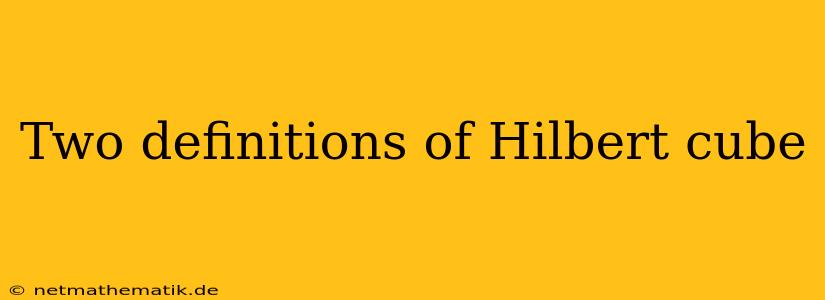The Hilbert cube, a fascinating object in topology, is renowned for its unique properties and applications. While the term "Hilbert cube" may conjure images of a simple cube, the reality is far more intricate. The Hilbert cube is not a simple cube in the traditional sense but a more complex, infinite-dimensional space. There are two primary definitions of the Hilbert cube, both leading to the same topological space but offering distinct perspectives on its construction. Understanding these definitions provides a crucial framework for comprehending the Hilbert cube's remarkable characteristics.
The First Definition: The Infinite Product of Unit Intervals
The first definition of the Hilbert cube builds upon the concept of an infinite product of topological spaces. Consider the unit interval, denoted as [0, 1], a familiar object in real analysis. The Hilbert cube, according to this definition, is the infinite product of countably many copies of the unit interval. This means that each point in the Hilbert cube is represented by an infinite sequence of real numbers, each ranging from 0 to 1.
Formal Notation
Formally, we can express this definition as:
I<sup>∞</sup> = [0, 1] × [0, 1] × [0, 1] × ...
where I represents the unit interval [0, 1] and the superscript ∞ signifies an infinite number of copies.
Visualization
While visualizing the Hilbert cube in its entirety is impossible due to its infinite dimensionality, we can gain some intuition by considering its finite-dimensional analogs. For instance, the 2-dimensional Hilbert cube is a square, the 3-dimensional Hilbert cube is a cube, and so on. As we increase the number of dimensions, we get closer to visualizing the Hilbert cube, but the true picture lies in the infinite limit.
The Second Definition: The Metric Space Approach
The second definition of the Hilbert cube utilizes the concept of metric spaces. This definition defines the Hilbert cube as a certain metric space whose elements are infinite sequences of real numbers. The metric used in this definition is known as the Hilbert metric, and it measures the distance between two points in the Hilbert cube by taking the sum of the squared differences of their corresponding coordinates, all multiplied by a factor of 1/2<sup>n</sup>, where n is the index of the coordinate.
Hilbert Metric
The Hilbert metric is formally defined as:
d(x, y) = √(Σ<sub>n=1</sub><sup>∞</sup> (1/2<sup>n</sup>) * (x<sub>n</sub> - y<sub>n</sub>)<sup>2</sup>)
where x and y are two points in the Hilbert cube, and x<sub>n</sub> and y<sub>n</sub> represent their corresponding coordinates in the infinite sequence.
Properties of the Hilbert Metric
The Hilbert metric induces a topology on the space of infinite sequences, making it a metric space. It satisfies the usual properties of a metric, such as being non-negative, symmetric, and satisfying the triangle inequality. Notably, this metric is also complete, meaning that any Cauchy sequence in the space converges to a point within the space.
Key Properties of the Hilbert Cube
Both definitions of the Hilbert cube lead to the same topological space, possessing several remarkable properties:
- Compactness: The Hilbert cube is compact, meaning that any infinite sequence of points in the Hilbert cube has a subsequence that converges to a point within the Hilbert cube. This property stems from the fact that the unit interval is compact, and the infinite product of compact spaces is also compact.
- Separability: The Hilbert cube is separable, meaning that it contains a countable dense subset. This means that any point in the Hilbert cube can be approximated arbitrarily well by a point in the countable dense subset.
- Connectedness: The Hilbert cube is connected, meaning that it cannot be partitioned into two non-empty open sets. This property is a consequence of the fact that the unit interval is connected and the infinite product of connected spaces is also connected.
Applications of the Hilbert Cube
The Hilbert cube finds applications in various areas of mathematics, including:
- Functional Analysis: The Hilbert cube serves as a fundamental object in functional analysis, particularly in the study of Banach spaces and Hilbert spaces. Its properties allow for the construction of various important function spaces.
- Topology: In topology, the Hilbert cube plays a crucial role in studying compact spaces, as it provides a universal model for all separable, metrizable, and compact spaces.
- Mathematical Logic: In mathematical logic, the Hilbert cube arises in the study of infinite games and descriptive set theory.
- Computer Science: The Hilbert cube finds applications in computer science, particularly in areas like machine learning and data mining.
Conclusion
The Hilbert cube, despite its infinite dimensionality, is a rich and fascinating object in mathematics. Its two primary definitions, through infinite products and metric spaces, offer different perspectives on its construction and properties. Its compactness, separability, and connectedness make it a fundamental object in topology and other branches of mathematics. Its applications in functional analysis, mathematical logic, and computer science highlight its versatility and relevance in various disciplines. Studying the Hilbert cube unveils the intricate connections between different mathematical concepts and its profound impact on our understanding of infinite-dimensional spaces.
